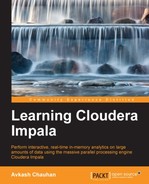Previously we discussed the Impala daemon, statestore, and metastore in detail to understand how they work together. Essentially, Impala daemons receive queries from a variety of sources and distribute the query load to Impala daemons running on other nodes. While doing so, it interacts with the statestore for node-specific updates and accesses the metastore, either stored in the centralized database or in the local cache. Now to complete the Impala execution, we will discuss how Impala interacts with other components, that is, Hive, HDFS, and HBase.
We have already discussed earlier the Impala metastore using the centralized database as a metastore, and Hive also uses the same MySQL or PostgreSQL database for the same kind of data. Impala provides the same SQL-like query interface used in Apache Hive. Since both Impala and Hive share the same database as a metastore, Impala can access Hive-specific table definitions if the Hive table definition uses the same file format, compression codecs, and Impala-supported data types for their column values.
Apache Hive provides various kinds of file-type processing support to Impala. When using formats other than a text file, that is, RCFile, Avro, and SequenceFile, the data must be loaded through Hive first and then Impala can query the data from these file formats. Impala can perform a read operation on more types of data using the SELECT statement and then perform a write operation using the INSERT statement. The ANALYZE TABLE statement in Hive generates useful table and column statistics and Impala uses these valuable statistics to optimize the queries.
Impala table data are actually regular data files stored in HDFS and Impala uses HDFS as its primary data storage medium. As soon as a data file or a collection of files is available in a specific folder of a new table, Impala reads all of the files regardless of their names, and new data is included in files with the name controlled by Impala. HDFS provides data redundancy through the replication factor and relies on such redundancy to access data on other DataNodes in case it is not available on a specific DataNode. We have already learned earlier that Impala also maintains the information on the physical location of the blocks about data files in HDFS, which helps data access in case of node failure.
HBase is a distributed, scalable, big data storage system that provides random, real-time read and write access to data stored on HDFS. HBase, a database storage system, sits on top of HDFS; however, like other traditional database storage systems, HBase does not provide built-in SQL support. Third-party applications can provide such functionality.
To use HBase, first the user defines tables in Impala and then maps them to the equivalent HBase tables. Once a table relationship is established, users can submit queries into the HBase table through Impala. Join operations can also be formed including HBase and Impala tables.
